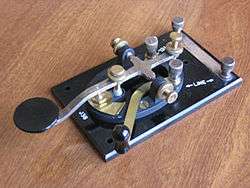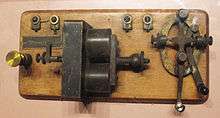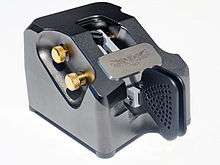Telegraph key


Telegraph key is a general term for any switching device used primarily to send Morse code. Similar keys are used for all forms of manual telegraphy, such as in ‘wire’ or electrical telegraph and ‘wireless’ or radio telegraphy.
Types of keys
Since its original inception, the telegraph key's design has developed such that there are now multiple types of keys.
Straight keys
A straight key is the common telegraph key as seen in various movies. It is a simple bar with a knob on top and a contact underneath. When the bar is depressed against spring tension, it forms a circuit and allows electricity to flow. Traditionally, American telegraph keys had flat topped knobs and narrow bars (frequently curved). British telegraph keys had ball shaped knobs and thick bars. This appears to be purely a matter of culture and training, but the users of each are tremendously partisan. Straight keys have been made in numerous variations for over 150 years and in numerous countries. They are the subject of an avid community of key collectors. The straight keys used in wire telegraphy also had a shorting bar that closed the electrical circuit when the operator was not actively sending messages. This was to complete the electrical path to the next station so that its sounder would operate, as in the operator receiving a message from the next town. Although occasionally included in later keys for reasons of tradition, the shorting bar is unnecessary for radio telegraphy, except as a convenience when tuning the transmitter.
The straight key is simple and reliable, but the rapid pumping action needed to send a string of dots (or dits as most operators call them) poses some significant drawbacks.
Transmission speeds vary from 5 words (25 characters) per minute, by novice operators, up to about 30 words (150 characters) per minute by skilled operators. In the early days of telegraphy, a number of professional telegraphers developed a repetitive stress injury known as glass arm or telegrapher's paralysis. ‘Glass arm’ or ‘Telegrapher's paralysis’ may be reduced or eliminated by increasing the side play of the straight key by loosening the adjustable trunnion screws. Such problems can be avoided by using a good technique.[1][2][3]
Many movies depicting the use of straight keys (e.g., World War II submarine movies, or near the end of the modern science fiction film Independence Day) expose the actors’ lack of training: They invariably lightly tap the key with one or two fingers, when the proper method is to grasp the knob with the thumb and two or three fingers. [4]
Alternative key designs
The first widely accepted alternative key was the sideswiper or sidewinder, sometimes called a cootie key. This key uses a side-to-side action with contacts in both directions and the arm spring-loaded to return to center. A series of dits could be sent by rocking the arm back and forth. The alternating action produces a distinctive rhythm or swing which noticeably affects the operator's transmission style (known as his ‘fist’), hence the name iambic. Although the sideswiper is seldom seen or used today, nearly all advanced keys use some form of side-to-side action.
A popular side-to-side mechanical key is the semi-automatic key or bug, sometimes known as a Vibroplex key, after the company that first manufactured them. When the paddle is pressed to the left it makes a continuous contact suitable for sending dashes (or dahs, as most operators call them). When the paddle is pressed to the right, a horizontal pendulum is set into motion which rocks against the contact points, sending a series of short pulses (dits) at a speed which is controlled by the position of the pendulum weight. A skilled operator can achieve sending speeds in excess of 40 words per minute with a ‘bug’.

Like the bug, the electronic keyer operates sideways. When pressed to one side the electronics generate a series of dahs and when pressed the other way, a series of dits. Most electronic keyers include a dit memory function which frees the operator from the need to perfectly time his transitions in the sequence dah-dit-dah. With dit memory, if the operator's keying action is about one dit ahead of the actual transmission, the keyer's output for each letter will be machine-perfect. An iambic keyer sports dual paddles, one for dit and one for dah; pressing both at the same time produces an alternating dit-dah-dit-dah sequence. Electronic keyers allow very high speed transmission of code.
An additional advantage of electronic keyers over semiautomatic keys is that code speed may be easily regulated and changed with electronic keyers, typically by turning a knob. With a semiautomatic key, the location of the pendulum weight must be readjusted to change the dit speed.[5]
Iambic (dual-lever) Paddles

Keys offering one contact for dits (left key) and another for dahs (right key) are called ‘iambic paddles’ if both contacts may be closed simultaneously. The ‘iambic’ function (alternating dits and dahs similar to a sequence of iambs in poetry) are created with an electronic keyer by squeezing the paddles together;[6][7] for that reason, iambic keys are also called squeeze keys.
A single-paddle also utilizes separate contacts for dits and dahs, but there is no ability to make both contacts simultaneously by squeezing the paddles together (iambic). When a single-paddle key is used with an electronic keyer, continuous dits are created by holding the dit side. Likewise, continuous dahs are created by holding the dah contact.
Iambic keying or squeeze keying creates alternating dits and dahs. This makes sending some characters easier, like the letter C, by merely squeezing the two paddles together. In single-paddle, non-iambic keying, the hand motion would require alternating four times for C (dah-dit-dah-dit).
Iambic keyers function in one of at least two major modes: Mode A and Mode B.
Mode A is the original iambic mode, in which alternate dots and dashes are produced as long as both paddles are depressed. When the paddles are released, the keying stops with the last dot or dash that was sent while the paddles were depressed.
Mode B is the second mode, which devolved from a logic error in an early iambic keyer. In mode B, dots and dashes are produced as long as both paddles are depressed. When the paddles are released, the keying continues by sending one more element, i.e., a dot if the paddles were released during a dash, or a dash if the paddles were released during a dot. Users accustomed to one mode usually find it difficult to use the other, so all competently designed keyers allow for selection of the desired keyer mode. If forced to use a keyer with an unaccustomed mode, the user must revert to single paddle mode in which both paddles are never depressed simultaneously.
Typically, single and dual-paddle keys use horizontal movements, while a straight-key utilizes an up and down movement. The benefit of iambic keying has recently been discussed in terms of movements per character and timings for high speed CW.[8]
Non-telegraphy uses of keys
Simple telegraph-like keys were long used to control the flow of electricity in laboratory tests of electrical circuits. Often, these were simple ‘strap’ keys in which a bend in the key lever provided the key's spring action. Telegraph keys were once used in the study of operant conditioning with pigeons. Starting in the 1940s, initiated by B. F. Skinner at Harvard University, the keys were mounted vertically behind a small circular hole about the height of a pigeon's beak in the front wall of an operant conditioning chamber. Electromechanical recording equipment detected the closing of the switch whenever the pigeon pecked the key. Depending on the psychological questions being investigated, keypecks might have resulted in the presentation of food or other stimuli. Modern pigeon response keys are specially made switches but are still called ‘keys’ due to their origins as telegraph keys.
With straight keys, side-swipers, and, to an extent, bugs, each and every telegraphist has his or her own unique style and pattern when transmitting a message. An operator's style is known as his ‘fist’. To other telegraphers, every fist is unique, and can be used to identify the telegrapher transmitting a particular message. This had a huge significance in the world wars, as it could be used to track the location of individual ships and submarines. See traffic analysis. However, electronic keyers (single paddle or iambic) will produce ‘perfect’ Morse at a set speed, thus only inter-character and inter-word spacing can produce a semblance of a fist.
See also
Notes and references
- ↑ How to operate a straight key https://www.youtube.com/watch?v=ncOcgarGJHI&feature=youtu.be
- ↑ Technique Of Hand Sending (1944) https://www.youtube.com/watch?feature=endscreen&NR=1&v=nVkLr0GyJPI
- ↑ Straight Key hand sending technique as approved by professionals https://www.youtube.com/watch?v=x6ggckXtZjs
- ↑ Shannon, John, K3WWP's Straight Key Page, retrieved 2010-07-05
- ↑ How to Properly Adjust and Use a Vibroplex Bug https://www.youtube.com/watch?v=qekmyx31Uxw
- ↑ Arduino CW Keyer, K3NG: http://blog.radioartisan.com/arduino-cw-keyer/
- ↑ How to use an iambic keyer: https://www.youtube.com/watch?v=ZdzjvIk_aY0
- ↑ Iambic Keying - Debunking the Myth, Marshall G. Emm, N1FN http://www.morsex.com/pubs/iambicmyth.pdf
External links
| Wikimedia Commons has media related to Telegraph keys. |
- Sparks Telegraph Key Review - A pictorial review of telegraphy and telegraph keys with an emphasis on spark (wireless) telegraphy.
- The Telegraph Office - A resource for telegraph key collectors and historians
- The Keys of N1KPR
- The Art and Skill of Radio Telegraphy
- Development of the Morse Key
- Telegraph Keys - An online resource for identification of all types of telegraph instruments